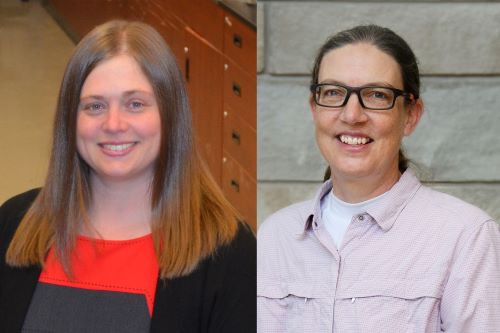In a profession that prides itself on solving problems, gender equity remains perhaps the most elusive goal for the engineering industry.
That challenge is the reason International Women in Engineering Day is celebrated each year on June 23.
Though there are a number of Chairs for Women in Engineering in Canada — tasked to increase participation of women in sciences and engineering — just two are independently funded at universities in Ontario and charged to focus on internal strategies and objectives.
Thanks to a gift from an anonymous alumni donor, Heidi Ploeg became Queen’s inaugural Chair for Women in Engineering in 2020. Ploeg met recently with her newly appointed counterpart at the University of Guelph to discuss the unique challenges and opportunities of their roles.
Jana Levison, an Associate Professor at the University of Guelph (U of G), was named in November 2022 the Doody Family Chair for Women in Engineering. She is a graduate of Queen’s (Sc’04, PhD’09 Civil Engineering) who researches agricultural and climate change impacts on groundwater quality in the School of Engineering at U of G.

“Jana and I, and our teams, started meeting regularly in the Winter term to compare progress and share some of the experiences that we’ve had. We are also included in a broader Canadian network. Jana and I were both invited to participate in the BIRS Workshop Network of Collaborations for Women in Science, Technology, Engineering, and Mathematics” says Ploeg, regarding the entire collective of Chairs for Women in Science and Engineering across Canada. “They had a summit, last December, where we all met together and discussed issues related to women in engineering and research in engineering. It’s really a community.”
“There’s also the Ontario Network for Women in Engineering,” says Levison. “We are working with ONWiE on initiatives such as the annual ONWiE Summit, and hosting events such as GoEngGirl.” Kim Jones, an Associate Professor in the Department of Chemical Engineering at McMaster University, is the current Chair of ONWiE.
“Right now the priorities are retention and climate,” says Ploeg, regarding the challenges, the current work before them. “Making our engineering community inclusive. Engineering does not have a great reputation for being an inclusive and welcoming community.”
“Climate and retention are big issues for women who drop out of engineering early in their career,” says Levison. “At Guelph we’re focused on outreach too, to get the word out to younger students about what engineering is. Often people don’t know what engineers do. It’s such a broad and diverse profession. We want people to know they can focus on healthcare applications or environmental applications. It’s not just building bridges or cars.”
“I feel like the COVID years amplified some of the gaps that we were aware of,” says Ploeg, “in the classroom and also as faculty members. COVID helped make some of the issues more obvious. Having a role like the Chair for Women in Engineering gives students a place to bring their feedback. They might not be comfortable bringing feedback directly to people in the classrooms, the faculty members or the T.A.s who are evaluating them. Or their classmates. It’s good to have a separate place that will listen to them.”
“Students are aware when things are not right,” she adds, “and they want things to be right. They will bring my attention to these things and then together we can try to find a suitable solution for their particular cases.”
Specifically, both pinpoint microaggressions as the leading source affecting the climate of engineering.
“In groups, women are often put into roles where they’re notetaking or doing project management and less technical work” says Levison. “That’s something that I’ve observed a lot.” As well, when student design teams partner with industry clients, there are cases where the professional client has directed technical questions exclusively to male team members.
“They’re often not doing it on purpose,” says Ploeg. “It just happens, and so I think as faculty members our job is to make people aware of it. We can also build a little structure into the design teams, so the roles for example are deliberately rotated among the team members. Students are here to learn, so we can lead them to pick roles where they grow and not continue with what they’ve been doing all along.”
What are the end goals of these roles? "When we don’t have to say ‘women in engineering’ anymore. We’re all just engineers," says Ploeg. "When everyone who’s participating in engineering feels welcome and feels like they have a place in the profession," Levison adds.
"That’s the way we’re going to be able to solve the engineering challenges," says Ploeg, "these large challenges that we’re all facing. We need everybody at the table and everybody to perform at their best, and not have these social constraints that don’t need to be there."